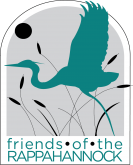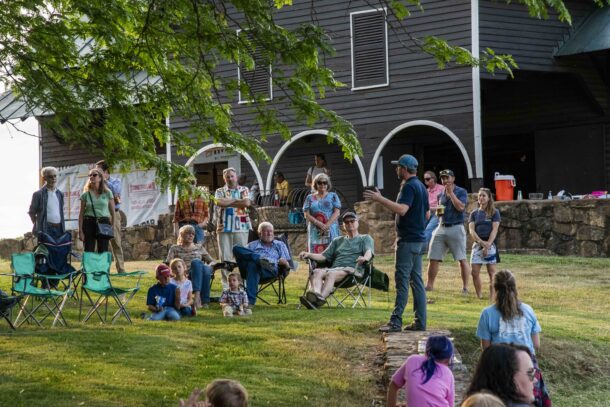Field Trip Programs

At the River’s Edge Environmental Education Program
At the River’s Edge provides students with interactive, outdoor science and history education opportunities.
Our goal is to give teachers and students a safe, fun, hands-on experience that will inspire respect and stewardship for the Rappahannock and its watershed. Our curriculum is aligned with the VA Standards of Learning and National Science Standards and includes programs suitable for preschool through high school and beyond.
Descriptions of our programs and registration information follow. Please contact us at [email protected] for more information.
Registration Information
Program Fees: $8 per child/student (snorkeling and boating prices vary, call for details). $80 registration fee (applied to the total program fee). Payment balance due the day of the program unless prior arrangements have been made. Minimum group visit is $80 (10 students). Adult chaperones are free. Special arrangements may be possible for groups where cost would otherwise prevent participation.
Location: River’s Edge Nature Preserve is located at 3219 Fall Hill Avenue, Fredericksburg, VA 22401
Preschool
Program B (1.5 hrs): Walk Like the Animals – Use your senses to discover how the forest and river provide a good place for animals to live.
Program C (1.5 hrs): Water Properties – Why does the river look different at different times? Little scientists will love to experiment with this question while learning about our beloved Rappahannock River.
Kindergarten & First Grade
Program A (3 hrs): VA Science SOL’s: K.1, K.3, K.4, K.5, K.6, K.7, K.9, 1.1, 1.4, 1.5, 1.6, 1.7, 1.8
- River Investigation Hike – Investigate the river habitat with your senses – observing, describing, and charting. Discover how animals use their senses for survival.
- Trees – Gain a better understanding of tree parts, trees as a resource, and why trees are so important to our river.
- Life in the River Habitat – Explore many different plants and animals along the river and discover why they live next to the river.
Environmental STEM or E-STEM – Our E-STEM program offerings engage students in learning about the renewable natural resources of water, wind, or solar energy. Students design, engineer, and test solutions to environmental challenges while completing design challenges. E-STEM is creativity and functionality in one succinct bundle of environmental fun.
Program B (3 hrs): Choose one of the E-STEM challenges below (Option 1 or Option 2) and one of the bulleted offerings from Program A (above) to create your own experience VA Science SOL’s: K.1, K.2, K.3, K.4, K.5, K.11, 1.1, 1.2, 1.3, 1.8
- E-STEM Option 1 Storm Drain Litter Catcher Design Challenge – Learn the top pollutants in the Rappahannock River while discovering the importance of our stormdrain systems. How can humans use storm drains to keep our water clean?
- E-STEM Option 2 Build A Barge – The Rappahannock River is used for travel, commerce, and recreation. Students experiment with the properties that cause items to sink and float then design and build their own barges. Which team’s barge will float the most weight!?!
- After you have chosen E-STEM Option 1 or 2, pick a bullet from Program A to design the unique field trip for your students.
Second & Third Grades
Program A (3.5 hrs): VA Science SOLs: 2.1, 2.3, 2.4, 2.5, 2.7, 2.8, 3.1, 3.5, 3.6, 3.7
- Wetlands: Snowden and Beyond – Hike to a wetland ecosystem, learning about plants and animals along the way. Deduce how wetlands help wildlife and the river.
- Just Around the River Bend – Explore the diversity of plant and animal life, their inter-dependency, and their relationship with the river.
- Water Cycle Game or Food Web Game (choose 1) – Both of these activities cover important topical vocabulary disguised as a fun game!
Program B (3.5 hrs.): VA Science SOLs: 2.1, 2.3, 2.5, 2.7, 2.8, 3.1, 3.4, 3.7, 3.8; History and Social Science SOLs: 2.2, 2.6
- Signs of Seasonal Change – Why do the leaves change colors and drop from some trees? How do animals survive during winter? Collect and analyze evidence of seasonal change to answer these and other questions.
- Rappahannock Connections – Discover how the Rappahannocks, an American Indian Tribe of the Eastern Woodlands, used their natural resources to meet life needs. Investigate their respect for nature through pottery, artifacts, and oral tradition.
Environmental STEM or E-STEM – Our E-STEM program offerings engage students in learning about the renewable natural resources of water, wind, or solar energy. Students design, engineer, and test solutions to environmental challenges while completing design challenges. E-STEM is creativity and functionality in one succinct bundle of environmental fun.
Program C (3.5 hrs.):Choose one of the E-STEM challenges below (Option 1 or Option 2) and one of the bulleted offerings from Programs A or B (above) to create your own experience. VA Science SOLs: 2.1, 2.2, 3.1, 3.2, 3.7, 3.8
- E-STEM Option 1 Paddleboat Design Challenge – Students learn about renewable natural energy while designing paddleboats that use stored chemical energy (batteries) or solar energy (with sun cooperation). Students will learn about basic electrical concepts as they design boats that will be tested on the river!
- E-STEM Option 2 Windmill Design Challenge – Students discuss how humans use renewable natural energy in wind to generate energy that will perform work. Students discover how windmills convert moving air into usable mechanical energy.
- After you have chosen E-STEM Option 1 or 2, pick a bullet from Program A or B to design the unique field trip for your students.
Fourth & Fifth Grades
4th and 5th Grades
Program A (3.5 hrs): VA Science SOLs: 4.1, 4.3, 4.8, 5.1, 5.8
- We All Live Downstream – Deduce the benefits of riparian buffer zones along our river, discuss erosion and pollution’s impact, and propose solutions.
- What Is A Watershed? – Where does the water go? Manipulate a model of a watershed to better understand human impacts on ecosystems.
- Commit to Conserve – Find out how you can protect our waterways and commit to an action that will help.
Program B (3.5 hrs): History and Social Science SOLs: VS.1, VS.2, VS.3, VS.4; USI.1, USI.2, USI.3, USI.5; VA Science SOLs: 4.3, 4.8, 5.9
- Survivor: John Smith – Visit the northwest extent of John Smith’s exploration of the Rappahannock, comparing Virginia resources now and then. Through tasks and role playing, simulate the Jamestown settlers’ effort to survive and fulfill responsibilities to the Virginia Company and the King.
- Rappahannock Connections – Discover how the Rappahannocks, an American Indian Tribe of the Eastern Woodlands, adapted to their environment and used their natural resources. Investigate their respect for nature through pottery, artifacts, and oral tradition.
Environmental STEM or E-STEM – Our E-STEM program offerings engage students in learning about the renewable natural resources of water, wind, or solar energy. Students design, engineer, and test solutions to environmental challenges while completing design challenges. E-STEM is creativity and functionality in one succinct bundle of environmental fun.
Program C (3.5 hrs): Choose one of the E-STEM challenges below (Option 1 or Option 2) and one of the bulleted offerings from Programs A or B (above) to create your own experience. VA Science SOLs: 4.1, 4.3, 4.8, 5.1, 5.2, 5.9, 6.1, 6.4, 6.6, 6.8, 6.9
- E-STEM Option 1 Stormwater Sediment Filter Design Challenge – Learn the top pollutants in the Rappahannock River while discovering the importance of our stormdrain systems. Students learn while they engineer stormwater filters for the top pollutant.
- E-STEM Option 2 Hydro Power Design Challenge – Students will discover how humans harness and use the renewable natural resource of water as they design and test their own prototypes.
- After you have chosen E-STEM Option 1 or 2, pick a bullet from Program A or B to design the unique field trip for your students.
Secondary (6th-12th)
Program A (3.5 hrs): Science SOLs: 6.1, 6.6, 6.8, 6.9; LS.1, LS.3, LS.4, LS.5, LS.6, LS.7, LS.8, LS.9, LS.10, LS.11; ES.1, ES.6, ES.8, ES.10; Environmental Science; Ecology ·
- Water Quality and Protection – Students will perform both biological and chemical water quality tests. Biological tests include benthic macro invertebrate sampling; chemical tests include data collection via handheld digital probeware and traditional chemical tests.
- Riparian Buffer Hike or Wetlands Hike (choose 1) – Students will learn why these ecosystems are important by investigating their impact on our watershed.
Environmental STEM or E-STEM – Our E-STEM program offerings engage students in learning about the renewable natural resources of water, wind, or solar energy. Students design, engineer, and test solutions to environmental challenges while completing design challenges. E-STEM is creativity and functionality in one succinct bundle of environmental fun.
Program C (3.5 hrs): Choose an all E-STEM field trip or a combination! Either choose two of the E-STEM challenges below (Option 1, Option 2 or Option 3) or one E-STEM option and one of the bulleted offerings from Programs A (above) to create your own experience. VA Science SOLs: 6.1, 6.4, 6.6, 6.8, 6.9
- E-STEM Option 1 Stormwater Sediment Filter Design Challenge – Learn the top pollutants in the Rappahannock River while discovering the importance of our stormdrain systems. Students learn while they engineer stormwater filters for the top pollutant.
- E-STEM Option 2 Hydro Power Design Challenge – Students will discover how humans harness and use the renewable natural resource of water as they design and test their own prototypes. Extenstions include testing how much load prototypes can pull and how much energy is generated using an ammeter.
- E-STEM Option 3 Wind Turbine Design Challenge – Students will discover how humans harness and use the renewable natural resource of wind as they design and test their own prototypes. Extensions include testing how much load prototypes lift and how many LED lights will stay lit.
Additional Programming
Additional Programming
- Nature Journaling (appropriate for 2nd-8th grades) – Discover the value of natural places using science, history, and art. Hone your observation skills and record nature along the scenic Rappahannock River.
- River Safety (appropriate for 3rd-8th grades) – (Health SOLs: 4.1. 6.1, 6.2, 7.1, 7.2) Learn to evaluate river safety conditions in order to enjoy the river safely. Interactive and hands-on, but all on dry land.
- Water Quality Testing by Canoe/Kayak (12 yrs. and up) – (Science SOLs: 6.1, 6.6, 6.8, 6.9; LS.1, LS.3, LS.4, LS.5, LS.6, LS.7, LS.8, LS.9, LS.10, LS.11; ES.1, ES.6, ES.8, ES.10; Environmental Science; Ecology) Collect water samples from different tributaries of the Rappahannock by canoe/kayak. Complete chemical water quality tests of the different samples to compare and analyze.
Meaningful Watershed Educational Experience (MWEE) Programming
4th Grade
Program (3.5 hrs): VA Science SOLs: 4.1, 4.3, 4.8
- MWEE Issue Definition Element Option 1: We All Live Downstream – Deduce the benefits of riparian buffer zones along our river, discuss erosion and pollution’s impact, and propose solutions.
- MWEE Issue Definition Element Option 2: E-STEM Stormwater Sediment Filter Design Challenge – Learn the top pollutants in the Rappahannock River while discovering the importance of our stormdrain systems. Students learn while they engineer stormwater filters for the top pollutant.
- MWEE Outdoor Field Experience Element: Water Quality and Protection – Students will perform both biological and chemical water quality tests. Biological tests include benthic macro invertebrate sampling; chemical tests include data collection via handheld digital probeware and traditional chemical tests. (Grade appropriate. Not as in depth as older grades.)
6th and 9th Grades
Program (3.5 hrs): Science SOLs: 6.1, 6.6, 6.8, 6.9; Environmental Science; Ecology
- MWEE Issue Definition Element: E-STEM Stormwater Sediment Filter Design Challenge – Learn the top pollutants in the Rappahannock River while discovering the importance of our stormdrain systems. Students learn while they engineer stormwater filters for the top pollutant.
- MWEE Outdoor Field Experience Element: Water Quality and Protection – Students will perform both biological and chemical water quality tests. Biological tests include benthic macro invertebrate sampling; chemical tests include data collection via handheld digital probeware and traditional chemical tests.

